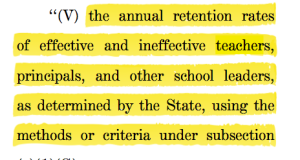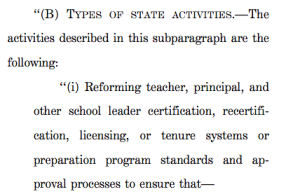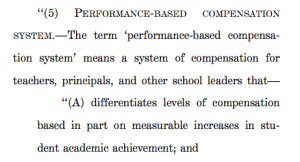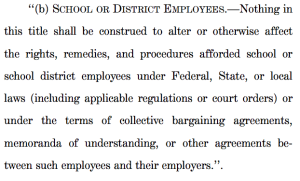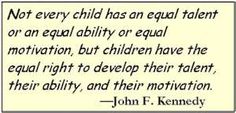In What You Need to Know about the Every Child Achieves Act by the American Federation of Teachers (AFT), AFT says “the Bill Is Better than the Current Law, Race to the Top, and Waivers.”………..UPDATE Dec. 5 – the name has been changed to the Every Student Succeeds Act (ESSA still S.1177) and on Dec. 10, it was signed into law. This information is still what people need to know and consider….
“Better” is the standard that leadership has set for this nation?
I ask you to consider; is it the best we can do for the American public education system and the children in that system? Do we have no higher expectation of congress, after the eight year wait, than to make the law “better” than No Child Left Behind (NCLB)? What about the right thing to do?
The Bill in question is The Every Child Achieves Act (S.1177, previously written as The Every Child College or Career Ready Act slanted for debate on July 7th). IT has many moving parts as does its House counterpart (both obviously written by the education industry representing themselves).
AFT says, “It restores the original intent of the groundbreaking 1965 ESEA law.”
DOES IT? (Update now that it is law: it did not.)
AFT says, “the intent was to address poverty and educational inequality. This bill ensures that resources continue to be directed to where they are most needed.”
DOES IT?
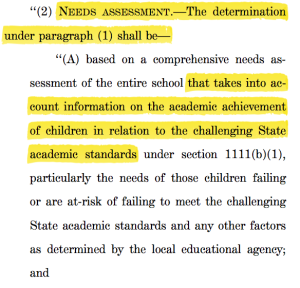
This continues the standards-based theory that led to a narrow curriculum…which is devastating TO poor kids.
The bill mentions a needs assessment but associates the needs assessment with achievement scores and standards…
….and does not require review by the U.S. Department of Education to assess whether or not the money granted does go towards meeting children’s real needs.
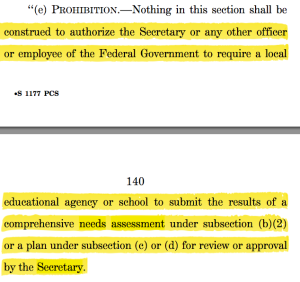
Keep in mind, WE must submit our plan for standards and testing but NOT our needs assessment….please, question this logic.
The original intent in 1965 was to strengthen and improve educational quality and educational opportunity.
The Every Child Achieves Act (S.1177) focuses on standards-based achievement, assessments of achievement, and charter expansion. The focus has not changed from what we had with No Child Left Behind. Have these things strengthened and improved educational quality and opportunity for all children?
AFT says, The Every Child Achieves Act “takes a crucial first step toward smarter assessments and accountability.”
Smarter assessments? In document after document — like Marc Tucker’s “Tough Choices or Tough Times” and the Smart Options (how to spend our Recovery Act dollars) —standards and testing were always seen as a first step where the truly crucial first step is addressing children’s learning needs and opportunity-to-learn resources.
In addition, keeping federal emphasis on testing perpetuates the fallacy that achievement test scores are valuable while the reality is they are an extremely poor and UNETHICAL way to judge the quality of education. We need to do away with that deceptive idea. And the next crucial step would be to define opportunity to learn indicators (which we have but don’t use).
AFT says the Every Child Achieves Act “maintains the current law’s annual testing requirements, but allows assessments to be delivered in the form of portfolios, projects or extended performance tests.
There is actually a BIG “IF” in the law… if states can demonstrate the alternative assessments are valid and reliable AS compared to the standards-based achievement tests. This means not only continuing with the achievement tests but also having the State resources and capability to validate what you are using, or farm it out to the testing industry.
Consider this, students’ grades and the quality of their courses continue to be more reliable than standardized test scores when it comes to trying to predict success in higher education.
AFT says the Every Child Achieves Act “allows accountability systems to include multiple non-test measures.”
“ALLOWS”??? (And the word was used in multiple places)??? If that doesn’t tell you that we have gone from an equal opportunity law to a federally controlled accountability law, I don’t know what does.
BUT, who was held accountable for the devastating effects of No Child Left Behind?
AFT says The Every Child Achieves Act “gives states authority to determine interventions for struggling schools.” …..
Sigh…What if you live in a state that lacks the capacity to improve schools? What if schools were identified for 8 and 9 years under NCLB as “In Needs of Improvement”? Then when the NCLB waivers changed terminology to “Focus” and “Priority” schools, what if those same schools went on the lists and your state still never did anything proven effective to help them improve? This true-to-life scenario is why the law existed to begin with. Why think this is a good thing for all states? Are all states offering equal access to quality education? And why do we continue to ignore what works when we could support it through law?
The Every Child Achieves Act is NOT an equal opportunity or educational improvement law reflective of the original intent of ESEA.
AFT says The Every Child Achieves Act “takes the federal government out of teacher evaluations.”
The Every Child Achieves Act requires teachers be labeled and that information goes on the State report card.
AFT says, “The federal government will not be the human resources department for every school district nationwide.”
Did they read the law? The Every Child Achieves Act will incentivize human resource development through the training of leadership to evaluate teachers calling it the Teacher and School Leader Incentive Program. They are looking at “human capital.” And it will be controlled through “State plans”.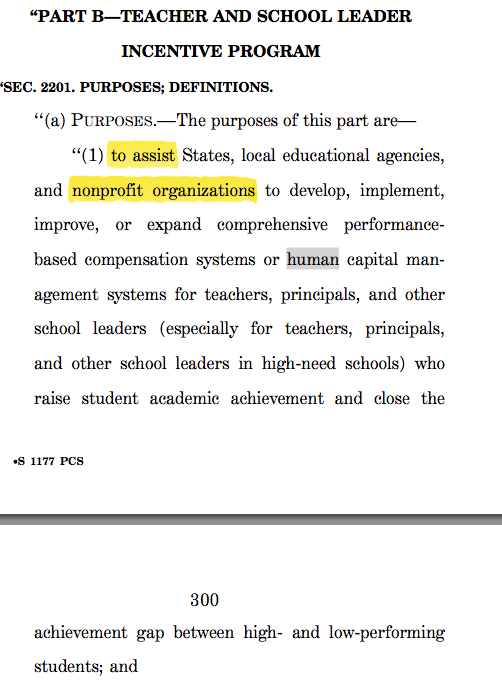 ….Look at all the components…..
….Look at all the components…..
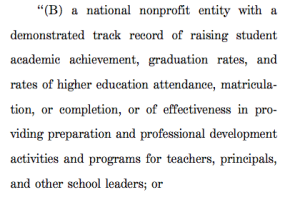
Those in the education reform wars can probably name off a slew of “national non-profits” who stand to gain on this one.
AFT says, The Every Child Achieves Act “expands collective bargaining protections to include both school improvement initiatives and teacher quality provisions.” WHERE???????
And what AFT doesn’t talk about that is in the bill are huge expansions for charter schools and other modes of privatization including the specifics of pre-schools……WOW!!!! Do we have a budding industry there!
What’s missing from the bill? Plenty! Gone is the whole sense of community-led improvement that was embodied in the original Elementary and Secondary Education Act….How can anyone say we have nothing better to offer in replacing No Child Left Behind? Where’s the suggestion box?
Or are those in power afraid of competing ideas?
Tell Congress NO on this one. Better than NCLB isn’t good enough for American education.


